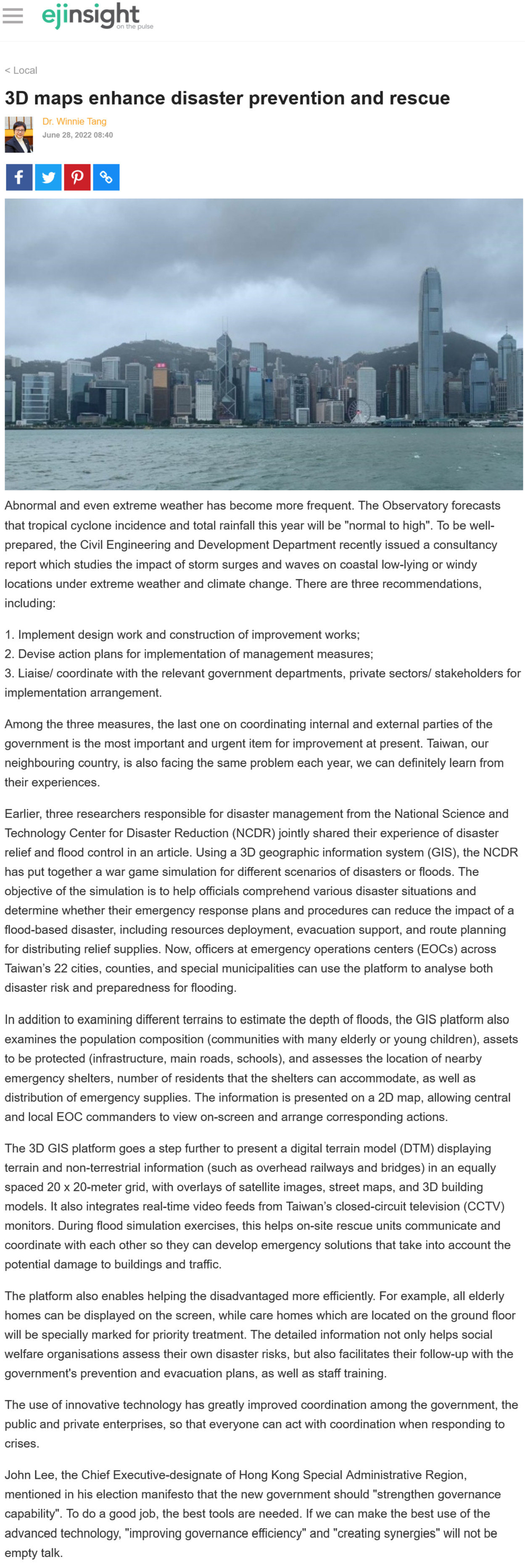網上版請按此

3D maps enhance disaster prevention and rescue
Abnormal and even extreme weather has become more frequent. The Observatory forecasts that tropical cyclone incidence and total rainfall this year will be "normal to high". To be well-prepared, the Civil Engineering and Development Department recently issued a consultancy report which studies the impact of storm surges and waves on coastal low-lying or windy locations under extreme weather and climate change. There are three recommendations, including:
1. Implement design work and construction of improvement works;
2. Devise action plans for implementation of management measures;
3. Liaise/ coordinate with the relevant government departments, private sectors/ stakeholders for implementation arrangement.
Among the three measures, the last one on coordinating internal and external parties of the government is the most important and urgent item for improvement at present. Taiwan, our neighbouring country, is also facing the same problem each year, we can definitely learn from their experiences.
Earlier, three researchers responsible for disaster management from the National Science and Technology Center for Disaster Reduction (NCDR) jointly shared their experience of disaster relief and flood control in an article. Using a 3D geographic information system (GIS), the NCDR has put together a war game simulation for different scenarios of disasters or floods. The objective of the simulation is to help officials comprehend various disaster situations and determine whether their emergency response plans and procedures can reduce the impact of a flood-based disaster, including resources deployment, evacuation support, and route planning for distributing relief supplies. Now, officers at emergency operations centers (EOCs) across Taiwan's 22 cities, counties, and special municipalities can use the platform to analyse both disaster risk and preparedness for flooding.
In addition to examining different terrains to estimate the depth of floods, the GIS platform also examines the population composition (communities with many elderly or young children), assets to be protected (infrastructure, main roads, schools), and assesses the location of nearby emergency shelters, number of residents that the shelters can accommodate, as well as distribution of emergency supplies. The information is presented on a 2D map, allowing central and local EOC commanders to view on-screen and arrange corresponding actions.
The 3D GIS platform goes a step further to present a digital terrain model (DTM) displaying terrain and non-terrestrial information (such as overhead railways and bridges) in an equally spaced 20 x 20-meter grid, with overlays of satellite images, street maps, and 3D building models. It also integrates real-time video feeds from Taiwan's closed-circuit television (CCTV) monitors. During flood simulation exercises, this helps on-site rescue units communicate and coordinate with each other so they can develop emergency solutions that take into account the potential damage to buildings and traffic.
The platform also enables helping the disadvantaged more efficiently. For example, all elderly homes can be displayed on the screen, while care homes which are located on the ground floor will be specially marked for priority treatment. The detailed information not only helps social welfare organisations assess their own disaster risks, but also facilitates their follow-up with the government's prevention and evacuation plans, as well as staff training.
The use of innovative technology has greatly improved coordination among the government, the public and private enterprises, so that everyone can act with coordination when responding to crises.
John Lee, the Chief Executive-designate of Hong Kong Special Administrative Region, mentioned in his election manifesto that the new government should "strengthen governance capability". To do a good job, the best tools are needed. If we can make the best use of the advanced technology, "improving governance efficiency" and "creating synergies" will not be empty talk.
Dr. Winnie Tang
Adjunct Professor, Department of Computer Science, Faculty of Engineering; Department of Geography, Faculty of Social Sciences; and Faculty of Architecture, The University of Hong Kong